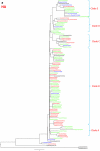Differences in the epidemiology and virology of mild, severe and fatal human infections with avian influenza A (H7N9) virus
- PMID: 26887968
- PMCID: PMC7101734
- DOI: 10.1007/s00705-016-2781-3
Differences in the epidemiology and virology of mild, severe and fatal human infections with avian influenza A (H7N9) virus
Abstract
A novel avian influenza A (H7N9) virus caused 5-10 % mild and 30.5 % fatal human infections as of December 10, 2015. In order to investigate the reason for the higher rate of fatal outcome of this infection, this study compared the molecular epidemiology and virology of avian influenza A (H7N9) viruses from mild (N = 14), severe (N = 50) and fatal (N = 35) cases, as well as from non-human hosts (N = 73). The epidemiological results showed that the average age of the people in the mild, severe and fatal groups was 27.6, 52 and 62 years old, respectively (p < 0.001). Males accounted for 42.9 % (6/14), 58.0 % (29/50), and 74.3 % (26/35) of cases in the mild, severe and fatal group respectively (p = 0.094). Median days from onset to start of antiviral treatment were 2, 5 and 7 days in the mild, severe and fatal group, respectively (p = 0.002). The median time from onset to discharge/death was 12, 40 and 19 days in the mild, severe and fatal group, respectively (p < 0.001). Analysis of whole genome sequences showed that PB2 (E627K), NA (R294K) and PA (V100A) mutations were markedly associated with an increased fatality rate, while HA (N276D) and PB2 (N559T) mutations were clearly related to mild cases. There were no differences in the genotypes, adaptation to mammalian hosts, and genetic identity between the three types of infection. In conclusion, advanced age and delayed confirmation of diagnosis and antiviral intervention were risk factors for death. Furthermore, PB2 (E627K), NA (R294K) and PA (V100A) mutations might contribute to a fatal outcome in human H7N9 infection.
Conflict of interest statement
None declared.
Figures












Similar articles
-
Epidemiological, clinical and viral characteristics of fatal cases of human avian influenza A (H7N9) virus in Zhejiang Province, China.J Infect. 2013 Dec;67(6):595-605. doi: 10.1016/j.jinf.2013.08.007. Epub 2013 Aug 16. J Infect. 2013. PMID: 23958687
-
Differences in the Epidemiology of Childhood Infections with Avian Influenza A H7N9 and H5N1 Viruses.PLoS One. 2016 Oct 3;11(10):e0161925. doi: 10.1371/journal.pone.0161925. eCollection 2016. PLoS One. 2016. PMID: 27695069 Free PMC article.
-
[Genomic sequences of human infection of avian-origin influenza A(H7N9)virus in Zhejiang province].Zhonghua Liu Xing Bing Xue Za Zhi. 2013 Jun;34(6):604-8. Zhonghua Liu Xing Bing Xue Za Zhi. 2013. PMID: 24125614 Chinese.
-
H7N9: preparing for the unexpected in influenza.Annu Rev Med. 2015;66:361-71. doi: 10.1146/annurev-med-010714-112311. Epub 2014 Oct 29. Annu Rev Med. 2015. PMID: 25386931 Review.
-
Did the Highly Pathogenic Avian Influenza A(H7N9) Viruses Emerged in China Raise Increased Threat to Public Health?Vector Borne Zoonotic Dis. 2019 Jan;19(1):22-25. doi: 10.1089/vbz.2018.2299. Epub 2018 Sep 15. Vector Borne Zoonotic Dis. 2019. PMID: 30222520 Review.
Cited by
-
Spatial characteristics and the epidemiology of human infections with avian influenza A(H7N9) virus in five waves from 2013 to 2017 in Zhejiang Province, China.PLoS One. 2017 Jul 27;12(7):e0180763. doi: 10.1371/journal.pone.0180763. eCollection 2017. PLoS One. 2017. PMID: 28750032 Free PMC article.
-
Novel Avian Influenza A Virus Infections of Humans.Infect Dis Clin North Am. 2019 Dec;33(4):907-932. doi: 10.1016/j.idc.2019.07.003. Infect Dis Clin North Am. 2019. PMID: 31668198 Free PMC article. Review.
-
Amino Acid Substitution K470R in the Nucleoprotein Increases the Virulence of H5N1 Influenza A Virus in Mammals.Front Microbiol. 2017 Jul 11;8:1308. doi: 10.3389/fmicb.2017.01308. eCollection 2017. Front Microbiol. 2017. PMID: 28744280 Free PMC article.
-
Novel pathogenic characteristics of highly pathogenic avian influenza virus H7N9: viraemia and extrapulmonary infection.Emerg Microbes Infect. 2020 Dec;9(1):962-975. doi: 10.1080/22221751.2020.1754135. Emerg Microbes Infect. 2020. PMID: 32267217 Free PMC article.
-
Nomogram for the Individualized Prediction of Survival Among Patients with H7N9 Infection.Risk Manag Healthc Policy. 2020 Mar 20;13:255-269. doi: 10.2147/RMHP.S242168. eCollection 2020. Risk Manag Healthc Policy. 2020. PMID: 32256136 Free PMC article.
References
-
- Chen Y, Liang W, Yang S, Wu N, Gao H, Sheng J, Yao H, Wo J, Fang Q, Cui D, Li Y, Yao X, Zhang Y, Wu H, Zheng S, Diao H, Xia S, Zhang Y, Chan KH, Tsoi HW, Teng JL, Song W, Wang P, Lau SY, Zheng M, Chan JF, To KK, Chen H, Li L, Yuen KY. Human infections with the emerging avian influenza A H7N9 virus from wet market poultry: clinical analysis and characterisation of viral genome. Lancet. 2013;381:1916–1925. doi: 10.1016/S0140-6736(13)60903-4. - DOI - PMC - PubMed
-
- Cowling BJ, Jin L, Lau EH, Liao Q, Wu P, Jiang H, Tsang TK, Zheng J, Fang VJ, Chang Z, Ni MY, Zhang Q, Ip DK, Yu J, Li Y, Wang L, Tu W, Meng L, Wu JT, Luo H, Li Q, Shu Y, Li Z, Feng Z, Yang W, Wang Y, Leung GM, Yu H. Comparative epidemiology of human infections with avian influenza A H7N9 and H5N1 viruses in China: a population-based study of laboratory-confirmed cases. Lancet. 2013;382:129–137. doi: 10.1016/S0140-6736(13)61171-X. - DOI - PMC - PubMed
Publication types
MeSH terms
Substances
LinkOut - more resources
Full Text Sources
Other Literature Sources
Medical

